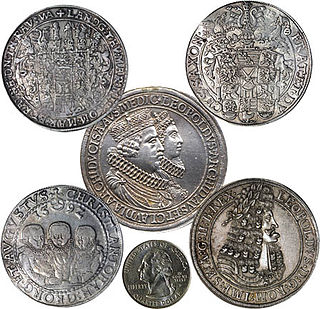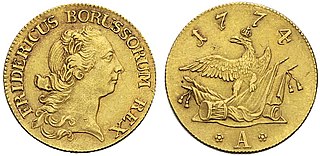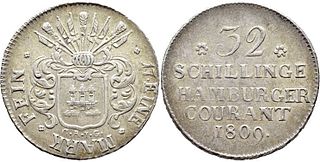Related Research Articles

A thaler or taler is one of the large silver coins minted in the states and territories of the Holy Roman Empire and the Habsburg monarchy during the Early Modern period. A thaler size silver coin has a diameter of about 40 mm and a weight of about 25 to 30 grams. The word is shortened from Joachimsthaler, the original thaler coin minted in Joachimsthal, Bohemia, from 1520.

Groschen is the name for various coins, especially a silver coin used in parts of Europe such as France, some of the Italian states, England, various states of the Holy Roman Empire, among others. The word is borrowed from the late Latin description of a tornose, a grossus denarius Turnosus, in English the "thick denarius of Tours". Groschen was frequently abbreviated in old documents to gl, whereby the second letter was not an l, but an abbreviation symbol; later it was written as Gr or g.

The German mark was the currency of the German Empire, which spanned from 1871 to 1918. The mark was paired with the minor unit of the pfennig (₰); 100 pfennigs were equivalent to 1 mark. The mark was on the gold standard from 1871 to 1914, but like most nations during World War I, the German Empire removed the gold backing in August 1914, and gold coins ceased to circulate.

The Vereinsthaler was a standard silver coin used in most German states and the Austrian Empire in the years before German unification.
The Silbergroschen was a coin used in Prussia and several other German Confederation states in northern Germany during the 19th century, worth one thirtieth of a Thaler.

The Reichsthaler, or more specifically the Reichsthaler specie, was a standard thaler silver coin introduced by the Holy Roman Empire in 1566 for use in all German states, minted in various versions for the next 300 years, and containing 25–26 grams fine silver.

The Thaler was the currency of the Free Hanseatic City of Bremen until 1873, when Germany adopted the gold mark (ℳ). It was divided into 72 Grote, each of 5 Schwaren. While initially identical to the North German thaler before the 1750s, it was the only currency to maintain the gold standard of 5 thalers to a Friedrich d'or pistole from the 1750s until 1873, long after all other states adopted the Conventionsthaler.

The Hamburg Mark refers to two distinct currencies issued in the city of Hamburg until 1875:
The Prussian Thaler was the currency of Prussia until 1857. In 1750, Johann Philipp Graumann implemented the Graumannscher Fuß with 14 thalers issued to a Cologne Mark of fine silver, or 16.704 g per thaler.
The Vereinsthaler was the currency of Prussia between 1857 and 1873. It replaced the Thaler at par and was replaced by the Mark at a rate of 1 Vereinsthaler = 3 Mark. The Vereinsthaler was subdivided into 30 Silbergroschen, each of 12 Pfennings.
The North German thaler was the currency of the Electorate and Kingdom of Saxony until 1857. Between 1754 and 1841, it was equal to three quarters of a Conventionsthaler and was subdivided into 24 Groschen, each of 12 Pfennig. In 1841, Saxony partially decimalized, dividing the Thaler into 30 Neugroschen, each of 10 Pfennig. The Thaler was replaced by the Vereinsthaler at par.
The Thaler was the currency of the Electorate, later Kingdom of Hanover until 1857. It was identical to the North German thaler except from 1754 to 1834 when it was worth 1/12 a Cologne Mark of fine silver. It was subdivided into 36 Mariengroschen, each of 8 Pfennig.
The Vereinsthaler was the currency of the two Grand Duchies of Mecklenburg-Schwerin and Mecklenburg-Strelitz between 1857 and 1873. It replaced the Mecklenburg Thaler at par and was replaced by the Mark at a rate of 1 Vereinsthaler = 3 Mark. The Vereinsthaler was subdivided into 48 Schillinge, each of 12 Pfenninge.
The North German thaler was the currency of the Landgravate, then Electorate of Hesse-Kassel until 1858. Until 1807, the Thaler was subdivided into 32 Albus, each of 12 Heller. It was worth 3⁄4th a Conventionsthaler from 1754 to 1841.

By the Hamburg Agreement on 8 March 1701, Mecklenburg was separated into two duchies with limited autonomy, which formed a collective state–as of 1815, the Grand Duchies of Mecklenburg-Schwerin and Mecklenburg-Strelitz. Since 1755, they had the same constitution and were under the control of the same parliament. In 1815, both parts became Grand Duchies by the Congress of Vienna.

The Grand Duchy of Mecklenburg Friedrich-Franz Railway was the state railway company in Mecklenburg-Schwerin and Mecklenburg-Strelitz. After its second nationalisation in 1890 up to the merger of the Länderbahnen into the Deutsche Reichsbahn in 1920 it was under the direction of the Grand Duchy's Executive Railway Board in Schwerin.

An Ephraimite was a debased coin part of whose silver content was replaced with copper. Ephraimites, as they came to be called, were issued under the authority of Frederick the Great of Prussia in the Duchy of Saxony and the Kingdom of Prussia from 1756 till 1763 during the Seven Years' War. The coins were spread by merchants and soldiers in Silesia, Bohemia, Poland and Courland and traded as if they were of official silver content. In return higher value foreign coins would be received, which could be used to pay the costs of army supply. By the end of 1762 Frederick the Great abandoned this policy. After the war the traditional content standards were restored.
The district duchy, also known as the district principality, was a type of the state under the patrimonial system, such as duchy or principality, formed in the feudal system, as a result of land partition between the members of a royal family. It occurred in the Middle Ages and early modern period, notably in Europe, in states such as the Holy Roman Empire, Duchy of Poland, and Kievan Rus'.
The North German thaler was a currency used by several states of Northern Germany from 1690 to 1873, first under the Holy Roman Empire, then by the German Confederation. Originally equal to the Reichsthaler specie or silver coin from 1566 until the Kipper und Wipper crisis of 1618, a thaler currency unit worth less than the Reichsthaler specie was first defined in 1667 and became widely used after adoption of the Leipzig currency standard of 1690.

The schilling was the name of a coin in various historical European states and which gave its name to the English shilling. The schilling was a former currency in many of the German-speaking states of the Holy Roman Empire, including the Hanseatic city states of Hamburg and Lübeck, the March of Brandenburg, and the Duchies of Bavaria, Mecklenburg, and Württemberg. It was also used in Switzerland and in Austria, where silver schillings were introduced as recently as 1923.
References
- ↑ Mar, Alexander Del (1895). History of Monetary Systems: Record of Actual Experiments in Money Made by Various States of the Ancient and Modern World, as Drawn from Their Statutes, Customs, Treaties, Mining Regulations, Jurisprudence, History, Archæology, Coins, Nummulary Systems, and Other Sources of Information. C.H. Kerr. p. 374.
